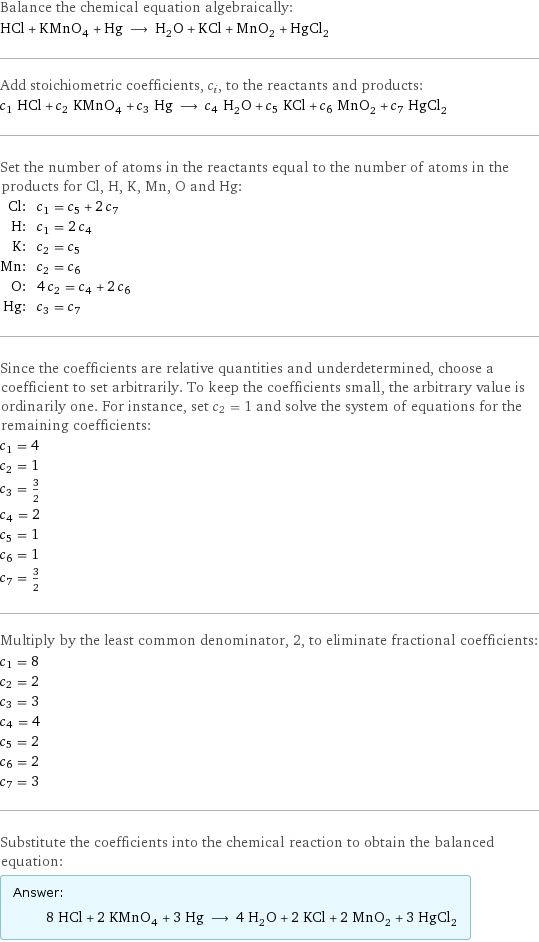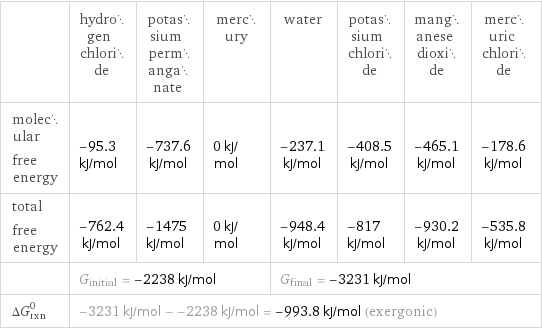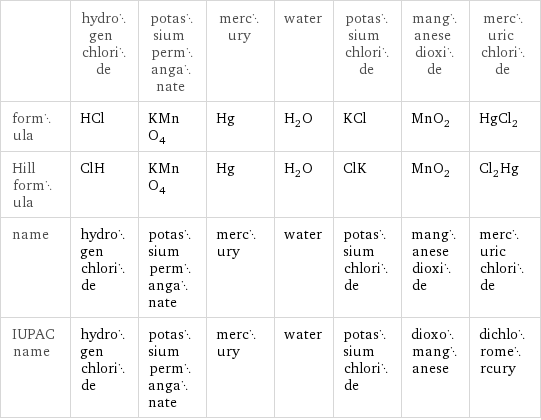Input interpretation

HCl hydrogen chloride + KMnO_4 potassium permanganate + Hg mercury ⟶ H_2O water + KCl potassium chloride + MnO_2 manganese dioxide + HgCl_2 mercuric chloride
Balanced equation

Balance the chemical equation algebraically: HCl + KMnO_4 + Hg ⟶ H_2O + KCl + MnO_2 + HgCl_2 Add stoichiometric coefficients, c_i, to the reactants and products: c_1 HCl + c_2 KMnO_4 + c_3 Hg ⟶ c_4 H_2O + c_5 KCl + c_6 MnO_2 + c_7 HgCl_2 Set the number of atoms in the reactants equal to the number of atoms in the products for Cl, H, K, Mn, O and Hg: Cl: | c_1 = c_5 + 2 c_7 H: | c_1 = 2 c_4 K: | c_2 = c_5 Mn: | c_2 = c_6 O: | 4 c_2 = c_4 + 2 c_6 Hg: | c_3 = c_7 Since the coefficients are relative quantities and underdetermined, choose a coefficient to set arbitrarily. To keep the coefficients small, the arbitrary value is ordinarily one. For instance, set c_2 = 1 and solve the system of equations for the remaining coefficients: c_1 = 4 c_2 = 1 c_3 = 3/2 c_4 = 2 c_5 = 1 c_6 = 1 c_7 = 3/2 Multiply by the least common denominator, 2, to eliminate fractional coefficients: c_1 = 8 c_2 = 2 c_3 = 3 c_4 = 4 c_5 = 2 c_6 = 2 c_7 = 3 Substitute the coefficients into the chemical reaction to obtain the balanced equation: Answer: | | 8 HCl + 2 KMnO_4 + 3 Hg ⟶ 4 H_2O + 2 KCl + 2 MnO_2 + 3 HgCl_2
Structures

+ + ⟶ + + +
Names

hydrogen chloride + potassium permanganate + mercury ⟶ water + potassium chloride + manganese dioxide + mercuric chloride
Reaction thermodynamics
Gibbs free energy

| hydrogen chloride | potassium permanganate | mercury | water | potassium chloride | manganese dioxide | mercuric chloride molecular free energy | -95.3 kJ/mol | -737.6 kJ/mol | 0 kJ/mol | -237.1 kJ/mol | -408.5 kJ/mol | -465.1 kJ/mol | -178.6 kJ/mol total free energy | -762.4 kJ/mol | -1475 kJ/mol | 0 kJ/mol | -948.4 kJ/mol | -817 kJ/mol | -930.2 kJ/mol | -535.8 kJ/mol | G_initial = -2238 kJ/mol | | | G_final = -3231 kJ/mol | | | ΔG_rxn^0 | -3231 kJ/mol - -2238 kJ/mol = -993.8 kJ/mol (exergonic) | | | | | |
Equilibrium constant
![Construct the equilibrium constant, K, expression for: HCl + KMnO_4 + Hg ⟶ H_2O + KCl + MnO_2 + HgCl_2 Plan: • Balance the chemical equation. • Determine the stoichiometric numbers. • Assemble the activity expression for each chemical species. • Use the activity expressions to build the equilibrium constant expression. Write the balanced chemical equation: 8 HCl + 2 KMnO_4 + 3 Hg ⟶ 4 H_2O + 2 KCl + 2 MnO_2 + 3 HgCl_2 Assign stoichiometric numbers, ν_i, using the stoichiometric coefficients, c_i, from the balanced chemical equation in the following manner: ν_i = -c_i for reactants and ν_i = c_i for products: chemical species | c_i | ν_i HCl | 8 | -8 KMnO_4 | 2 | -2 Hg | 3 | -3 H_2O | 4 | 4 KCl | 2 | 2 MnO_2 | 2 | 2 HgCl_2 | 3 | 3 Assemble the activity expressions accounting for the state of matter and ν_i: chemical species | c_i | ν_i | activity expression HCl | 8 | -8 | ([HCl])^(-8) KMnO_4 | 2 | -2 | ([KMnO4])^(-2) Hg | 3 | -3 | ([Hg])^(-3) H_2O | 4 | 4 | ([H2O])^4 KCl | 2 | 2 | ([KCl])^2 MnO_2 | 2 | 2 | ([MnO2])^2 HgCl_2 | 3 | 3 | ([HgCl2])^3 The equilibrium constant symbol in the concentration basis is: K_c Mulitply the activity expressions to arrive at the K_c expression: Answer: | | K_c = ([HCl])^(-8) ([KMnO4])^(-2) ([Hg])^(-3) ([H2O])^4 ([KCl])^2 ([MnO2])^2 ([HgCl2])^3 = (([H2O])^4 ([KCl])^2 ([MnO2])^2 ([HgCl2])^3)/(([HCl])^8 ([KMnO4])^2 ([Hg])^3)](../image_source/c3d7797888ce1463a41c5f7f554a0f2a.png)
Construct the equilibrium constant, K, expression for: HCl + KMnO_4 + Hg ⟶ H_2O + KCl + MnO_2 + HgCl_2 Plan: • Balance the chemical equation. • Determine the stoichiometric numbers. • Assemble the activity expression for each chemical species. • Use the activity expressions to build the equilibrium constant expression. Write the balanced chemical equation: 8 HCl + 2 KMnO_4 + 3 Hg ⟶ 4 H_2O + 2 KCl + 2 MnO_2 + 3 HgCl_2 Assign stoichiometric numbers, ν_i, using the stoichiometric coefficients, c_i, from the balanced chemical equation in the following manner: ν_i = -c_i for reactants and ν_i = c_i for products: chemical species | c_i | ν_i HCl | 8 | -8 KMnO_4 | 2 | -2 Hg | 3 | -3 H_2O | 4 | 4 KCl | 2 | 2 MnO_2 | 2 | 2 HgCl_2 | 3 | 3 Assemble the activity expressions accounting for the state of matter and ν_i: chemical species | c_i | ν_i | activity expression HCl | 8 | -8 | ([HCl])^(-8) KMnO_4 | 2 | -2 | ([KMnO4])^(-2) Hg | 3 | -3 | ([Hg])^(-3) H_2O | 4 | 4 | ([H2O])^4 KCl | 2 | 2 | ([KCl])^2 MnO_2 | 2 | 2 | ([MnO2])^2 HgCl_2 | 3 | 3 | ([HgCl2])^3 The equilibrium constant symbol in the concentration basis is: K_c Mulitply the activity expressions to arrive at the K_c expression: Answer: | | K_c = ([HCl])^(-8) ([KMnO4])^(-2) ([Hg])^(-3) ([H2O])^4 ([KCl])^2 ([MnO2])^2 ([HgCl2])^3 = (([H2O])^4 ([KCl])^2 ([MnO2])^2 ([HgCl2])^3)/(([HCl])^8 ([KMnO4])^2 ([Hg])^3)
Rate of reaction
![Construct the rate of reaction expression for: HCl + KMnO_4 + Hg ⟶ H_2O + KCl + MnO_2 + HgCl_2 Plan: • Balance the chemical equation. • Determine the stoichiometric numbers. • Assemble the rate term for each chemical species. • Write the rate of reaction expression. Write the balanced chemical equation: 8 HCl + 2 KMnO_4 + 3 Hg ⟶ 4 H_2O + 2 KCl + 2 MnO_2 + 3 HgCl_2 Assign stoichiometric numbers, ν_i, using the stoichiometric coefficients, c_i, from the balanced chemical equation in the following manner: ν_i = -c_i for reactants and ν_i = c_i for products: chemical species | c_i | ν_i HCl | 8 | -8 KMnO_4 | 2 | -2 Hg | 3 | -3 H_2O | 4 | 4 KCl | 2 | 2 MnO_2 | 2 | 2 HgCl_2 | 3 | 3 The rate term for each chemical species, B_i, is 1/ν_i(Δ[B_i])/(Δt) where [B_i] is the amount concentration and t is time: chemical species | c_i | ν_i | rate term HCl | 8 | -8 | -1/8 (Δ[HCl])/(Δt) KMnO_4 | 2 | -2 | -1/2 (Δ[KMnO4])/(Δt) Hg | 3 | -3 | -1/3 (Δ[Hg])/(Δt) H_2O | 4 | 4 | 1/4 (Δ[H2O])/(Δt) KCl | 2 | 2 | 1/2 (Δ[KCl])/(Δt) MnO_2 | 2 | 2 | 1/2 (Δ[MnO2])/(Δt) HgCl_2 | 3 | 3 | 1/3 (Δ[HgCl2])/(Δt) (for infinitesimal rate of change, replace Δ with d) Set the rate terms equal to each other to arrive at the rate expression: Answer: | | rate = -1/8 (Δ[HCl])/(Δt) = -1/2 (Δ[KMnO4])/(Δt) = -1/3 (Δ[Hg])/(Δt) = 1/4 (Δ[H2O])/(Δt) = 1/2 (Δ[KCl])/(Δt) = 1/2 (Δ[MnO2])/(Δt) = 1/3 (Δ[HgCl2])/(Δt) (assuming constant volume and no accumulation of intermediates or side products)](../image_source/4d53824d6d8e25023ad77f21e9377f98.png)
Construct the rate of reaction expression for: HCl + KMnO_4 + Hg ⟶ H_2O + KCl + MnO_2 + HgCl_2 Plan: • Balance the chemical equation. • Determine the stoichiometric numbers. • Assemble the rate term for each chemical species. • Write the rate of reaction expression. Write the balanced chemical equation: 8 HCl + 2 KMnO_4 + 3 Hg ⟶ 4 H_2O + 2 KCl + 2 MnO_2 + 3 HgCl_2 Assign stoichiometric numbers, ν_i, using the stoichiometric coefficients, c_i, from the balanced chemical equation in the following manner: ν_i = -c_i for reactants and ν_i = c_i for products: chemical species | c_i | ν_i HCl | 8 | -8 KMnO_4 | 2 | -2 Hg | 3 | -3 H_2O | 4 | 4 KCl | 2 | 2 MnO_2 | 2 | 2 HgCl_2 | 3 | 3 The rate term for each chemical species, B_i, is 1/ν_i(Δ[B_i])/(Δt) where [B_i] is the amount concentration and t is time: chemical species | c_i | ν_i | rate term HCl | 8 | -8 | -1/8 (Δ[HCl])/(Δt) KMnO_4 | 2 | -2 | -1/2 (Δ[KMnO4])/(Δt) Hg | 3 | -3 | -1/3 (Δ[Hg])/(Δt) H_2O | 4 | 4 | 1/4 (Δ[H2O])/(Δt) KCl | 2 | 2 | 1/2 (Δ[KCl])/(Δt) MnO_2 | 2 | 2 | 1/2 (Δ[MnO2])/(Δt) HgCl_2 | 3 | 3 | 1/3 (Δ[HgCl2])/(Δt) (for infinitesimal rate of change, replace Δ with d) Set the rate terms equal to each other to arrive at the rate expression: Answer: | | rate = -1/8 (Δ[HCl])/(Δt) = -1/2 (Δ[KMnO4])/(Δt) = -1/3 (Δ[Hg])/(Δt) = 1/4 (Δ[H2O])/(Δt) = 1/2 (Δ[KCl])/(Δt) = 1/2 (Δ[MnO2])/(Δt) = 1/3 (Δ[HgCl2])/(Δt) (assuming constant volume and no accumulation of intermediates or side products)
Chemical names and formulas

| hydrogen chloride | potassium permanganate | mercury | water | potassium chloride | manganese dioxide | mercuric chloride formula | HCl | KMnO_4 | Hg | H_2O | KCl | MnO_2 | HgCl_2 Hill formula | ClH | KMnO_4 | Hg | H_2O | ClK | MnO_2 | Cl_2Hg name | hydrogen chloride | potassium permanganate | mercury | water | potassium chloride | manganese dioxide | mercuric chloride IUPAC name | hydrogen chloride | potassium permanganate | mercury | water | potassium chloride | dioxomanganese | dichloromercury